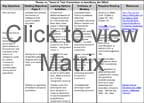Weekly Objectives
In this week you will...
- explore theories of intelligence and giftedness as they evolved through the years.
- study how the brain functions and how brain research impacts instruction.
- investigate the incidence of gifted students in your school district as it compares to other districts and the state.
- compare the myths and truths about gifted students.
Theory vs. Theory & Their Connection to Identifying the Gifted
This week we are going to enter a time capsule and journey back into the past. In order to better understand where we are as far as gifted education is today, we must uncover the history. Who were the pioneers in gifted research, did the first theorists set out to identify giftedness or were there other purposes in mind, how did they plan to identify the characteristics, traits, and uniqueness attributed to giftedness, and what were they going to do once they succeeded in their mission?
You will become familiar with the theorists, their theories, research – including the most recent object of scientists’ curiosity – the brain and how it functions, and the myths that have plagued referral processes along with the facts that provide educators with sound information and guidance.
It's Ancient History
From as far back as the time of Aristotle, people have been theorizing about giftedness. At one time giftedness was considered the equivalent of genius so the first standardized tests developed by psychologists measured intelligence.
As the years progressed, the validity of intelligence tests as a sole measure for giftedness came into question. The major feeling was that the tests were biased in favor of white, middle class children and penalized children with different linguistic styles.
A secondary realization was that more and more educators believed that giftedness also included “creativity, memory, motivation, physical dexterity, social adeptness, and aesthetic sensitivity.” (McClellan, 1985) If you have studied Howard Gardner you will recognize his theory of multiple intelligences coming into bloom. Eventually, this led to the generation of the Marland Report in 1972. The definition of giftedness contained in that report has been a major factor in the development of gifted programs to this day.
The theories connected to the definition of gifted and the identification of the gifted are as diverse as the theorists who developed them. Interpretation of the information, the identification process, and how services are delivered are also extremely varied. As you investigate many of these theories and the people behind them, you will notice the commonalities and the differences. Detailed information about the theorists and their theories can be found on the Human Intelligence website and in your reading assignment for Chapter 2 in your textbook. Be sure to check out the interactive map History of Influences in the Development of Intelligence Theory and Testing on the web site.
 You have had the opportunity to read about various theorists, the differences in their ideas, and have also seen the progression and development of the theories – how one idea can piggy-back off another idea. Check out your understanding and knowledge of these valued persons in the interactive activity. Are you now an expert? Clicking on the icon will launch the On Target "Meet and Match the Theorists" activity. A group of eight cards will be presented. The four cards on the left each show a name of one of the intelligence theorists. The four cards on the right each have a statement about a theorist. Your task is to drag the theorist card on the left to the correct statement card on the right. Once your cards are in place, you may check your answer.
You have had the opportunity to read about various theorists, the differences in their ideas, and have also seen the progression and development of the theories – how one idea can piggy-back off another idea. Check out your understanding and knowledge of these valued persons in the interactive activity. Are you now an expert? Clicking on the icon will launch the On Target "Meet and Match the Theorists" activity. A group of eight cards will be presented. The four cards on the left each show a name of one of the intelligence theorists. The four cards on the right each have a statement about a theorist. Your task is to drag the theorist card on the left to the correct statement card on the right. Once your cards are in place, you may check your answer.
What role do these theories, these ideals, play in the identification of potentially gifted children? Do gifted children fit into a specific group? Can you just pick them out of a crowd? What influence, if any, do family dynamics and culture play in the development of giftedness?

